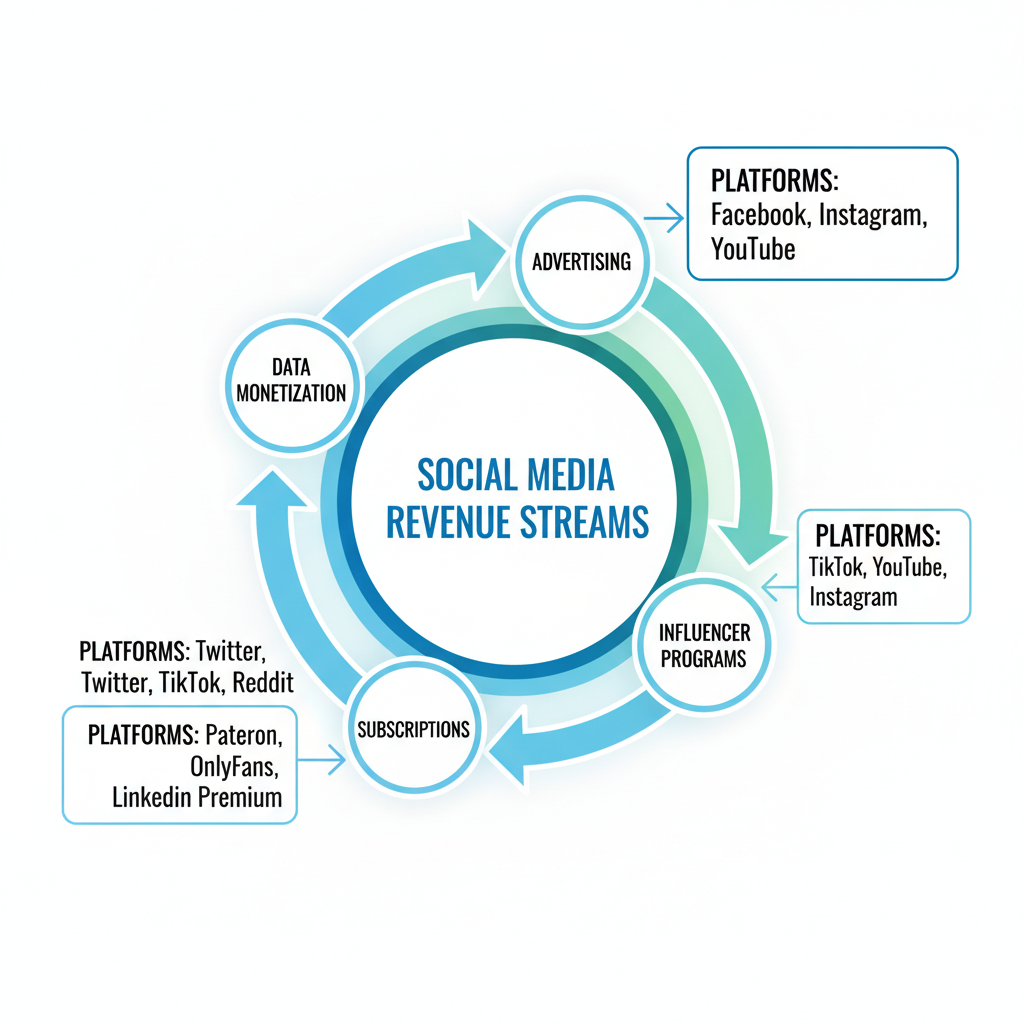How Social Media Makes Money with Revenue Models
Explore how social media platforms generate income through advertising, data monetization, subscriptions, e-commerce, and influencer partnerships.

Introduction: How Social Media Makes Money in the Digital Age
Social media platforms have evolved from basic networking hubs into complex, monetized ecosystems that dominate the online economy. In the early 2000s, sites like MySpace and Friendster relied mostly on banner ads and sponsorships. Today, giants such as Facebook, Instagram, Twitter (now X), TikTok, and YouTube deploy multi-channel revenue models that blend advertising, data monetization, subscriptions, e-commerce, and emerging technologies.
Understanding how social media makes money is essential for marketers, creators, and users alike, as these models shape not only our online experiences but also the strategies businesses use to engage us.

---
Advertising Revenue: Display Ads, Video Ads, and Sponsored Posts
Advertising is still the financial backbone of most social platforms. Businesses leverage varied ad formats to capture attention and drive conversions:
- Display Ads – Banner-style visuals placed in feeds, stories, or sidebars.
- Video Ads – Pre-roll, mid-roll, and post-roll placements in video content.
- Sponsored Posts – Paid updates blended into user feeds to resemble organic content.
Why Advertising Works in Social Media
- Massive Reach – BILLIONS of active monthly users enable quick scaling.
- Targeting Precision – Granular demographic, interest, and behavior filters.
- Measurable ROI – Real-time analytics for campaign optimization.
Sample ad campaign setup pseudo-code:
{
"campaign_name": "Summer Collection",
"audience": {
"age_range": [18, 35],
"interests": ["fashion", "travel", "photography"],
"location": "United States"
},
"ad_format": "carousel",
"budget": 5000,
"duration_days": 14
}
---
Data Monetization: User Information, Targeting, and Analytics
Platforms collect vast amounts of user data, including:
- Profile and demographic details
- Engagement and interaction logs
- Device type and location metadata
This data fuels precise ad targeting, informs product development, and generates revenue through analytics services.
How Data Drives Revenue
- Ad Targeting – Higher bid value for granular audience segments.
- Behavioral Insights – Enhance engagement and retention strategies.
- Market Research Reports – Sell anonymized trend data to enterprises.
| Type of Data | Revenue Opportunity | Example Use Case |
|---|---|---|
| Demographics | Ad targeting | Target female users aged 25–35 for a skincare campaign |
| Behavioral | Retention improvement | Adjust app notifications based on engagement patterns |
| Location | Local ads | Push offers from nearby retailers |
---
Subscription Models: Premium Access, Ad-Free, and Exclusive Content
With ad fatigue rising, subscription services provide an alternative monetization stream:
- Ad-Free Viewing – YouTube Premium removes advertising interruptions.
- Exclusive Material – Patreon-style bonus content for paid followers.
- Advanced Features – LinkedIn Premium offers expanded search tools.
Benefits for Platforms
- Predictable Revenue – Recurring payments smooth income volatility.
- Higher Retention – Subscribers are more invested in long-term engagement.
- Revenue Diversification – Reduces dependence on fluctuating ad budgets.
---
Influencer and Affiliate Programs: Collaborations and Commissions
Influencers have become a central part of social media economics. Platforms support them through:
- Brand Sponsorships – Paid campaigns aligning with influencer audiences.
- Affiliate Marketing – Trackable links earning commissions on sales.
These built-in program features simplify partnership management and performance tracking.

---
E-Commerce Integration: Shopping Within Social Platforms
Social shopping merges product discovery and purchase flow:
- Product Tagging – Instagram enables item tags in posts and stories.
- In-App Checkout – Eases purchasing by keeping users on-platform.
- Live Shopping – Hosts promote products in livestream events.
Advantages
- Increased conversions via low-friction buying paths.
- Social validation through likes, comments, and shares.
- Streamlined consumer journey from awareness to transaction.
---
Virtual Goods and Microtransactions: Low-Cost Digital Items
Digital products cater to personalization and engagement:
- Stickers – Popular in messaging apps like LINE.
- Profile Skins – Interface customization for user accounts.
- Digital Gifts – Sent during livestreams or special occasions.
Small transactions scale into major revenue when multiplied by millions of users.
---
Live Streaming Monetization: Real-Time Support and Events
Live streaming brings interactive monetization:
- Tips & Donations – Viewers contribute in real-time.
- Paid Broadcasts – Ticketed events on TikTok or YouTube Live.
- Monthly Live Access – Subscription-only event streams.
Revenue splits vary, but creators and platforms both benefit from direct viewer payments.
---
Marketplace Fees: P2P Sales Commissions
Social marketplaces enable user-to-user sales, and platforms take a percentage:
| Platform | Fee Type | Average Rate |
|---|---|---|
| Facebook Marketplace | Seller fee | 5% |
| Instagram Shop | Transaction fee | Varies by region |
| TikTok Shop | Commission | 5% – 8% |
Marketplace revenue enhances social media’s competition with traditional e-commerce sites.
---
Future Trends: AR/VR and AI Monetization
Emerging technologies present new opportunities:
- AR Shopping – Virtual try-ons for apparel or home goods.
- VR Social Events – Paid attendance at immersive concerts or expos.
- AI-Powered Ad Personalization – Real-time customization of promotions.
Early adoption could secure high-value consumer niches in the evolving metaverse.
---
Summary and Call to Action
The mechanisms behind how social media makes money reveal a rapidly diversifying landscape—with advertising, data, subscriptions, influencer partnerships, e-commerce, and immersive tech revenue streams working in parallel. For businesses, understanding these models is crucial for crafting competitive strategies. For users, awareness promotes smarter engagement choices.
Want to leverage these monetization strategies for your brand? Start analyzing your audience data and test multiple revenue models to see what resonates most.



